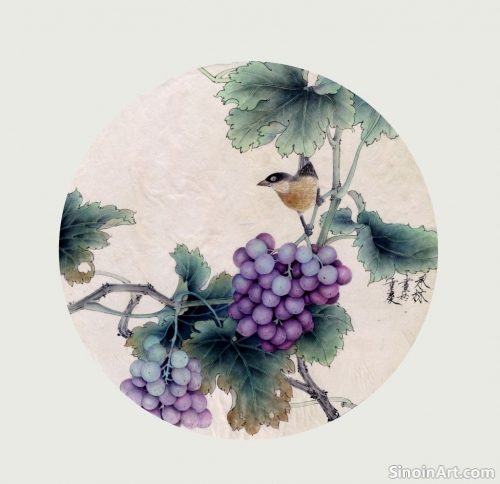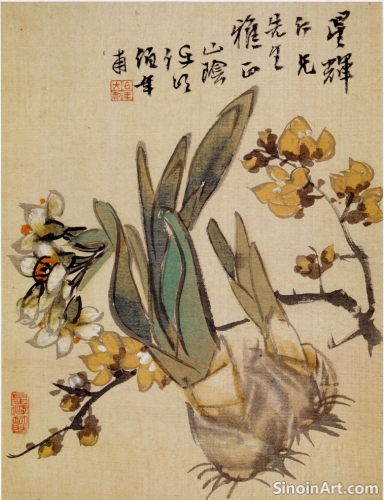The Delicate World of Gongbi: An Introduction
|
Gongbi, often translated as "meticulous" or "fine-line" painting, represents a significant and distinctive genre within traditional Chinese art. Unlike the more expressive and free-flowing styles of literati painting (xieyi), Gongbi focuses on precise brushstrokes, detailed representation, and vibrant colors. This intricate art form, which has deep historical roots, captures the beauty and complexity of the natural world, human figures, and historical narratives with remarkable skill and patience. It's a meticulous practice demanding rigorous training, keen observation, and a profound understanding of traditional materials and techniques.  The hallmark of Gongbi lies in its commitment to realistic detail. Artists use fine brushes, often made from wolf hair, to delineate every petal, feather, or facial feature with astounding precision. This process is not merely about replication; it's about capturing the essence and spirit of the subject matter. Each line is purposeful, contributing to the overall harmony and balance of the composition. The application of color is equally precise, with multiple layers of thin washes used to achieve subtle gradations and luminous effects. The vibrancy of these colors, often derived from natural minerals and pigments, is a defining feature of Gongbi.  Historical subjects, often drawn from folklore and mythology, feature prominently in Gongbi art. These works are not just visual representations but also narratives, offering glimpses into Chinese history and culture. The figures are often depicted with elegant poses, their clothing and accessories rendered with meticulous care. Landscapes also take center stage, with plants, animals, and rocks depicted with botanical and geological accuracy. Gongbi artists often create highly complex compositions, weaving together elements of flora, fauna, and architecture into captivating and detailed scenes.  The materials and tools used in Gongbi painting are integral to the finished product. Rice paper, often specially treated for painting, forms the support for the artwork. Chinese brushes, each with different characteristics and sizes, are essential for controlling the application of ink and color. Inksticks, ground with water on an inkstone, provide the essential black pigment. Natural pigments, such as malachite for green, azurite for blue, and vermilion for red, are carefully prepared and applied in multiple layers, creating rich and complex tones. The careful combination of these traditional materials and techniques contribute to the unique and sophisticated aesthetic of Gongbi. Today, Gongbi painting continues to evolve while maintaining its traditional roots. Contemporary artists are exploring new subjects and perspectives, pushing the boundaries of the art form while honoring its historical legacy. This evolution ensures that Gongbi remains a vibrant and relevant art form for both Chinese and international audiences. Understanding the meticulous techniques and profound artistry of Gongbi provides valuable insights into the rich tapestry of Chinese art history and cultural expression. |
Tag : Gongbi painting, Chinese art, meticulous painting, fine-line painting, traditional Chinese art
Related information
- Gongbi Painting and the Depiction of Auspicious Symbols
- Gongbi Portraiture: Capturing the Essence of the Subject
- The Conservation and Care of Gongbi Paintings
- Gongbi and the Depiction of Everyday Life
- The Meticulous Hand: Precision and Detail in Gongbi Painting
This article explores the use of auspicious symbols in Gongbi painting, highlighting the meaning and cultural significance of these motifs, and how their depiction in these detailed works expresses wishes for good fortune, prosperity, and happiness.
This article explores Gongbi portraiture, highlighting its meticulous detail, precise use of line, delicate color layering, and its aim to capture not only the physical likeness of the subject but also their inner character and essence.
This article provides essential information on the conservation and care of Gongbi paintings, including controlling the environment, proper storage, framing techniques, cleaning recommendations, and the importance of regular inspections to ensure the longevity of these delicate artworks.
This article explores the use of Gongbi painting in depicting scenes from everyday life, highlighting its meticulous detail, portrayal of common activities, and how these works serve as visual records of daily existence and a particular time and place.
Chinese Gongbi painting, distinguished by its meticulous detail and precise execution, stands as a testament to the dedication and technical skill of its practitioners. Unlike the expressive spontaneity of Xieyi (freehand) painting, Gongbi emphasizes a controlled and highly detailed approach, striving for a realistic depiction of the subject matter. This pursuit of perfection is central to the aesthetic and philosophy of the Gongbi tradition.